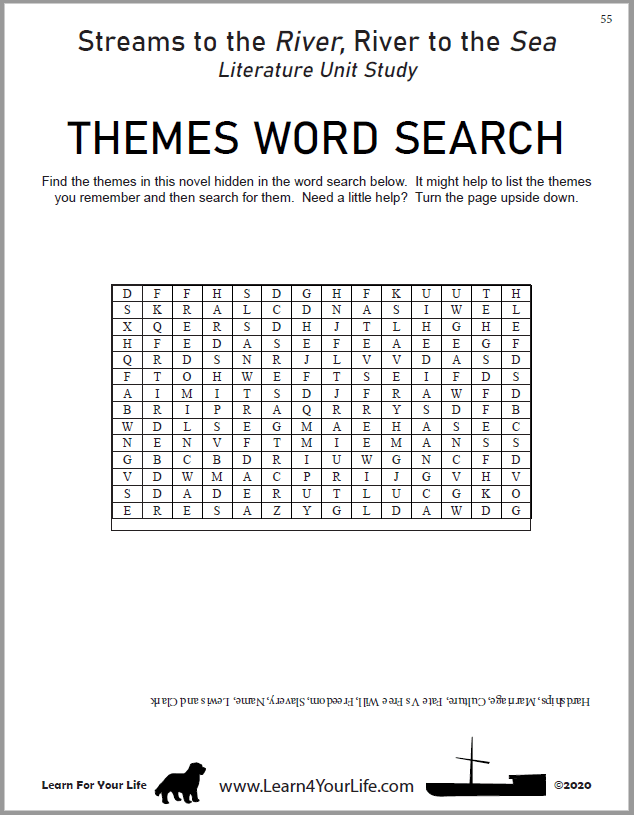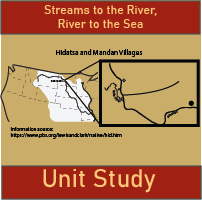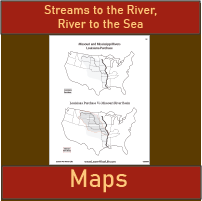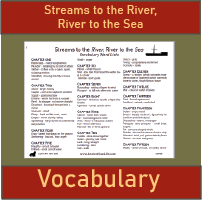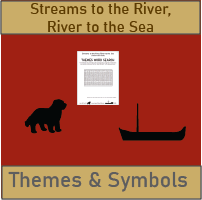
Streams to the River Themes and Symbols
This page summarizes the themes, symbols, action plot, and literary elements in Streams to the River, River to the Sea.
Themes
Throughout our Streams to the River Unit Study, students identify the themes in the chapter. Major themes of the book include:- Lewis and Clark Expedition
- Hardship
- Marriage
- Native American Culture
- Free Will
- Slavery
- Identity
Activities With Themes
The unit study provides these activities to highlight the themes of the book:- Reading comprehensive questions in the chapters regarding the theme
- Word Search of major themes (pictured above)
- Discussion on the fulfillment of the themes with Scott O'Dells ending narrative
Symbols and Motiffs in Streams to the River
River
The river is an obvious symbol and motiff. It is boldly featured in the title, in the opening sentence of the story, and throughout the chapters.The river is the pathway on which the journey occurs. It is the location of the opening and closing events as well as the "road" that the expedition travels.
Names
The motiff of name reflects the theme of identify. Sacagawea's name is not mentioned in the first chapters; she remains a nameless captive until Blue Sky inquires about her.She was given a nickname by Captain Clark, and even has a secret name that is never mentioned. In addition, her son is named Meeko, Pompey, and Jean Baptiste by different individuals.
Streams to the River Summary
Chapter by Chapter Action Plot
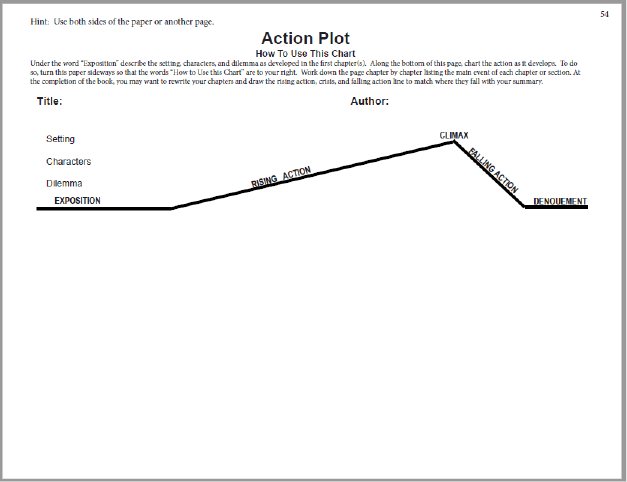
The main action of each chapter is plotted on the diagram.
- Chapter 1 - A Native American girl and her cousin Running Deer are captured in a raid.
- Chapter 2 - they are taken to Minnetaree village by Tall Rock.
- Chapter 3 - The wives of the chieftain accept the unnamed girl and plan for her to marry Red Hawk.
- Chapter 4 Running Deer escapes but Sacagawea chooses to stay in the village.
- Chapter 5 Tall Rock captures her again and takes her to the village of the cruel Le Borgne.
- Chapter 6 She escaped from Le Borgne and went to an uninhabited island.
- Chapter 7 - She is rescued from an island by a man and woman in a canoe
- Chapter 8 Three men claim her and a game will be played to see who gets to keep her. They are 1)Red Hawk, the son of the chieftain; 2) Le Borgne from the other village, and 3) Charbonneau, the trader who brought her off the island.
- Chapter 9 - Charbonneau, the French trader, wins the game. By law Sacagawea belongs to him.
- Chapter 10 - Blue Sky, the wife of the chieftain, demands Sacagawea stay in the lodge in their village instead of traveling with Charbonneau and his other Indian wife.
- Chapter 11 - Sacagawea married Charbonneau. He left to go trading in other village and she found out she was expecting a baby.
- Chapter 12 - Lewis and Clark’s company arrive in their village and get a friendly welcome
- Chapter 13 - Sacagawea and Charbonneau move to Fort Mandan where the expedition stayed for the winter because they will go further west as guides and interpreters. Her baby was born there.
- Chapter 14- The journey begins with Sacagawea and Charbonneau in the company. Sacagawea helps find food. She saves some of Captain Clark's possessions that go overboard. But she is suspicious that Charbonneau is planning trouble.
- Chapter 15 - In spite of multiple dangers and serious hardships, the journey continued. Each day was different than the one before. Attacks included: bear, beaver, aggression from a tribe, buffalo stampede, grasshopper cloud. Hardships included pulling the boats upstream through mud, skin puncturing thorns, and hunger.
- Chapter 16 - Sacagawea was sick. When she recovered she was with a small group that saw a Blackfoot raiding party. Charbonneau tried to take Sacagawea and escape by night, but he was caught.
- Chapter 17 - Arrive at conjunction of Missouri River and Maria River. Charbonneau predicts major changes for the plains when the white settlers come.
- Chapter 18 - Lewis forges ahead with a small party to make sure they are on the right river. They reach the Great Falls in spite of the danger of illness, heavy rains, flood, and rattlesnakes.
- Chapter 19 - Sacagawea is beaten by her husband for not starting a fire. They arrive in Shoshone country.
- Chapter 20 - In the Shoshone village, a conflict arose between Charbonneau and the Shoshone man who was promised to be Sacagawea’s husband by her father.
- Chapter 21 - Sacagawea makes a long trip to a cave to pray for Captain Clark and Meeko. She tells Clark she wants to continue to the ocean in spite of the warnings of her cousin and brother and husband.
- Chapter 22 - They leave the Shoshone village on horseback. After traveling a long way without food, they find a friendly Nez Perce village who promise to watch their horses while they continue by canoe. Charbonneau takes another wife who stays in her village as they continue.
- Chapter 23 - They follow the Columbia River and reach the edge of the Pacific Ocean. Sacgawea's boat was caught in a tidal swell. She was hurt when Captain Clark asked for her belt to trade for furs.
- Chapter 24 - The built Fort Clatsop near the Pacific Ocean. They interacted with the Clatsop Indians they did not trust. Sacagawea struggled to understand the concept of a round earth.
- Chapter 25 - They begin the journey up the Colorado on their way back towards Fort Mandan and away from the Pacific Ocean. They have less trading supplies and find the Indian tribes less friendly.
- Chapter 26 - The company split into two parties on their way back, then met at the meeting of the two rivers. Lewis went north along the Maria River and Clark went south along the Yellowstone River. Both encountered numerous obstacles. Charbonneau was briefly reunited with his third wife, who ended up leaving him to go back to her father's village.
- Chapter 27 - They return to Fort Mandan. Sacagawea refuses Clark's offer to go to St. Louis. As the Corps heads down the Missouri, she heads back toward the Shoshone with Baby Meeko.
Climax
The climax is marked by her decision to turn down Clark's offer and leave her husband as well her home with the Hidatsa.Denouement: What Happened to Sacagawea?
The Unit Study provides a brief recount of three different contradictory historical accounts of Sacagawea.Students contrast O'Dell's ending in Streams to the River to the three different historical accounts.
O'Dell's ending is unique but it serves a literary purpose. It brings the story full circle back to the beginning AND completes the narrative's themes:
- Lewis and Clark Expedition - It is over and she begins her own journey.
- Hardship - She chose the harder path. Staying with the Hidatsa would have been safer and easier.
- Marriage - She rejects her marriage.
- Native American Culture - She disobeys the laws by fleeing, but wants her son to grow up with her people.
- Free Will - She rejects the plans of Clark and Carbonneau and her adopted Hidatsa family.
- Slavery - She rejects the Hidatsa and chooses freedom among her own people who are poorer.
- Identity - She wants her son to identify as a Shoshone native.
Buy Streams to the River Unit Study
Literature Study Based on Scott O'Dell's novel about Sacagawea
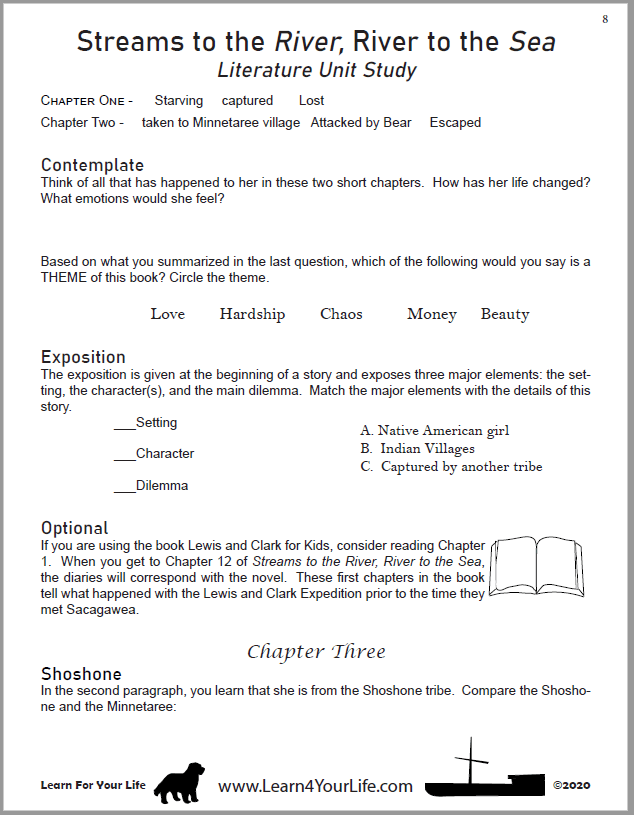
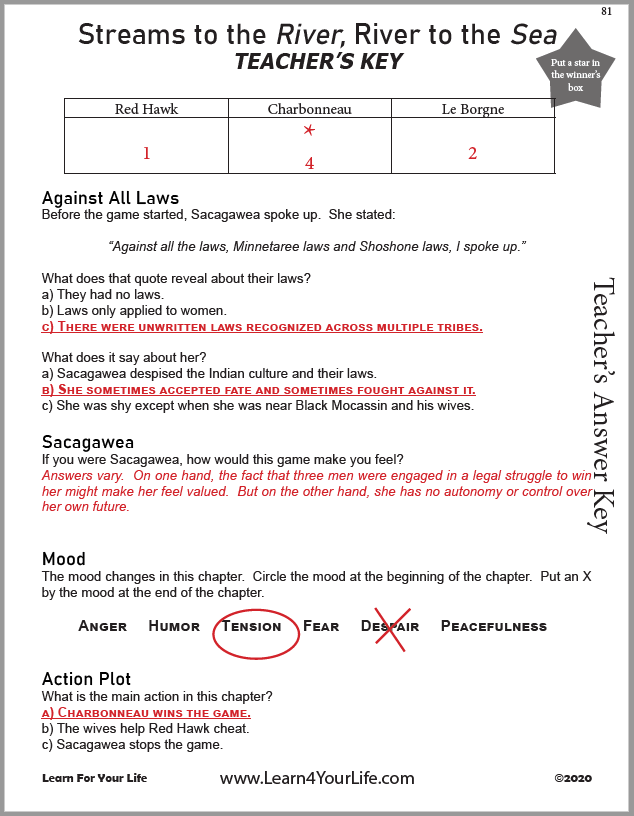
Student Guide AND Teacher's Answer Key Included
$2.99 Download - 121 pages
![]()
Streams to the River, River to the Sea
Information on the historical fiction novel about Sacagawea by Scott O'Dell

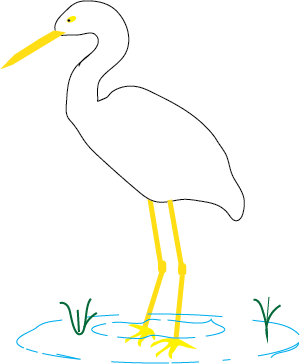
About Our Site
Hands-On Learning


